|
|
..
|
Dog Grooming Starter TipsGood grooming habits begin with puppy care. All puppies should be taught to sit, stand, or lie down to have their bodies checked over and their hair combed. Grooming provides bonding time. In the wild, wolves and other canines groom each other as part of the social interaction of the pack or family group. Dog incisors (the front teeth) are an effective comb; the little nibbles they etch on the bodies of pack mates stimulate the skin and have a calming effect. Puppy owners can also use grooming as pleasurable time with their new family member.
Tools
A basic home grooming kit for a long-coated dog should include a soft wire slicker brush, a comb that has both fine and coarse teeth, a Universal brush and mat comb for dealing with the tangles that do form, and an oil-based conditioner that is applied before brushing or combing the coat. The mat comb has long teeth that are inserted into the matrocked in a sawing motion to loosen the hairs. A kit for medium-coated or short-coated dogs should include a slicker brush or flexible-pin brush. Bony dogs should be brushed with a soft brush or one with blunt bristles. Feathery hairs on the legs, ears, and tail should be combed. A nubby glove or coarse rag is suitable for grooming faces and for stimulating the skin and conditioning the coat on short-coated dogs.
Bathing
For dogs that get bathed more than once a month, aloe-based shampoos and coat conditioners and foods and supplements with Omega fatty acids help maintain coat oils and skin health. * Before bathing, clear any mats or tangles from Ginger’s coat. * Teach her to stand in the tub, and then add warm or tepid water. * Soak to the skin, lather, then rinse thoroughly to prevent sticky coat and dry skin. * Keep water and soap out of her eyes and ears. * Clean her face and the insides of her ears with a sponge or washcloth.
Daily examinationEven if your pet doesn’t need daily grooming, check you dog thoroughly to make sure there are no cuts, sores, fleas, rashes, bumps, ticks, or hitchhikers in her coat or dirt in her ears. Remove fleas with a fine-toothed comb and drop them into a container of soapy water. Remove embedded ticks with tweezers or protected fingers and drop them in a vial of alcohol. Grasp the tick body, rock it back and forth, and then pull firmly. Carefully remove vegetative matter such as grass awns, seed casings, or thorny twigs with fingers or comb. During this exam, check your dog's feet and ears, look at her teeth, and feel for cuts or tumors.
Shedding
Shedding is controlled by hormonal changes that are tied to photoperiod (day length) and is influenced by level of nutrition and general state of health. In addition to natural biennial shedding, a dog may drop its coat after surgery, x-rays under anesthesia, and whelping puppies. Double-coated dogs that shed heavily are Akita, Alaskan Malamute, Keeshond, Siberian Husky, Samoyed, Norwegian Elkhound, Collie, Great Pyrenees, Kuvasz, Newfoundland, St. Bernard, English Toy Spaniel, Pomeranian, Belgian Sheepdog, Belgian Malinois, Belgian Tervuren, Australian Shepherd, German Shepherd, Smooth Collie, Shetland Sheepdog, and American Eskimo. The Dalmatian sheds constantly, and many dogs shed a moderate amount of hair. Owners should be aware before purchase that a long-coated dog, purebred or mixed, will require grooming throughout its life. If the inclination to groom or the time to do so is not part of the plan, provisions should be made for professional coat care for the dog. Otherwise, a dog that can do with a lick and a promise is a better choice as a family pet.
Skin
Grooming is essential for healthy skin, not so much for keeping it clean, but for making the owner aware of any problems that may be developing. Flea allergies can cause severe skin problems, so daily examination of the dog during flea season is a must. Contact allergies can also cause skin to break out. Irritated skin leads to scratching, which can open the skin to staphylococcus infections. An ounce of prevention is definitely worth a pound of cure for the dog and the pocketbook the antibiotics for skin infections are among the most expensive medications, and the cost of treatment can be dollars a day for a couple of weeks or longer. Skin irritations and infections can crop up overnight, so keep a close eye on the situation. Groom daily for fleas and ticks if Lad has had a problem. Use a fine-toothed comb to check for fleas, and then flick the tiny insects into a container of warm, soapy water. Remove ticks with protected fingers and drop in a vial of alcohol. Treat the house for fleas as well; modern controls for these pests use genetically altered natural insecticides, growth inhibitors, and drying agents that are both environmentally friendly and less toxic to people and pets. EarsAll dogs should have their ears checked periodically. Dogs with droop ears are especially susceptible to fungus and bacterial infections and should be checked at least weekly. Veterinarians can prescribe cleaning agents for ears to dry them out. Infected ears can also lead to further complications. Not only is the dog painfully uncomfortable, he may cause a hematoma by breaking a blood vessel while shaking his head in response to the discomfort. The hematoma may dissipate on its own if Rover stops shaking his head or it may grow and require lancing and stitching. FeetDogs should have their toenails cut every 2 to 3 weeks. A dog that wiggles during toenail clipping will sooner or later be nipped to the quick, and the next time the clippers come out of the closet, he'll head for the hills. So teach the dog to stand or sit still and offer his paw, clip a tiny bit off each nail a couple of days in a row, or have the vet or groomer do the job. Dog nails have a quick that can be seen as a darkening of light-colored nails but is invisible on dark nails. The quick has a nerve and blood supply; nicking the quick not only hurts the dog, it causes profuse bleeding, so keep a quick stop product on hand or use flour or cornstarch to stem the tide. Include an examination of the dog's feet into a grooming session to make sure there is nothing stuck between the pads. Seeds from some grasses can stab into the pad, pebbles can get stuck, chemicals used on lawns can burn, and fungus can cause irritation, which leads to licking, which can lead to hot spots and infection. A home-grooming session can be a boon to the dog-owner relationship. Dogs naturally groom each other to reinforce pack behavior and show subordination, and you can take advantage of this behavior. Spend 10-20 minutes every day or two, depending on the dog and the season of the year, and you'll increase the bond with your pet immeasurably along with insuring that you'll keep his skin and coat healthy and be aware of any subtle changes in condition. Choosing a groomer
Selection of a groomer should be done with at least as much care as choice of a barber or hair stylist, for you must be pleased with the results of the "haircut" and the dog must be treated with care while at the shop. Many veterinarians have incorporated grooming into their clinics, so you may start there. If your veterinarian is not associated with a groomer, he may have a list of recommended groomers. Other sources of recommendations include friends who own pets, boarding kennels that don't have their own grooming service, pet supply stores, shelters, and purebred breeders. If you own a Poodle or a terrier, the selection may be a bit more difficult, for these breeds have special grooming requirements that take more time and expertise. After getting some recommendations, make a few telephone calls and ask questions about services and costs, pick-up and delivery, and use of tranquilizers to calm the dog. Most groomers will not use tranquilizers; however, they will handle a dog that has been tranquilized by the veterinarian or owner if they know that the drug has been given. If your dog is geriatric or has a chronic medical problem, ask about special handling. Visit the groomers who answered your questions without the dog. Make sure the shop is well-lit, that the groomer and assistants handle the dogs gently, that old or arthritic dogs are treated with special consideration, and that the shampoos and flea and tick products meet your needs. If the shop is part of a boarding kennel, find out what vaccinations the kennel requires. If routine vaccinations, including Bordatella, are not required, be aware that Cactus may bring home more than a new hairdo. The owner's responsibilityHere are some hints to make a trip to the groomer easier on both you and your dog: 1. Teach the dog to stand on command and to accept the attentions of a stranger without cringing or growling. Obedience classes are wonderful for this good manners exercise, which is an integral part of the Canine Good Citizen test. 2. Comb Mango regularly to prevent tangles and mats or schedule more frequent visits to the groomer. Matted hair can cause great pain to the dog and to the groomer who gets bitten because Mango's in pain from tangled locks. 3. Crate train Monster so he'll sit quietly while drying and waiting for your return. 4. Warn the groomer of any bad habits that could interfere with successful grooming. If, in spite of all you can do, Monkey hates grooming and is likely to bite, tell the groomer so she can take precautions. If Peanut is tranquilized for the session, if she has a heart problem or is subject to seizures, if she has arthritis, or if she is extremely fearful, tell the groomer so she will be prepared. A groomer is not a miracle worker. He/She cannot take a poorly maintained dog and turn it into a show-stopper in one visit. You should maximize your chances of satisfaction by teaching the dog to accept the attentions of strangers and keeping the coat free of mats and tangles. HOPE THE INFORMATION PROVIDED IS HELPFUL! IF YOU HAVE INFORMATION YOU WOULD LIKE TO SHARE CONTACT US. |
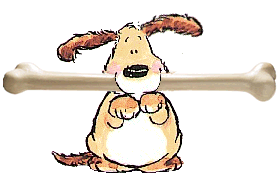
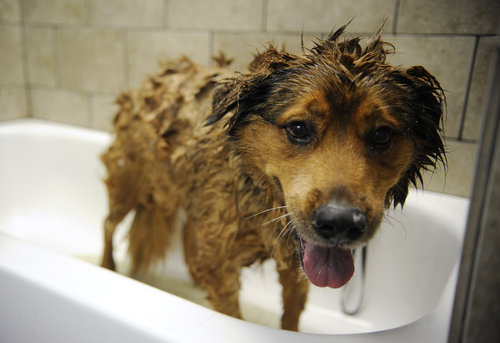 Most Dogs do not need frequent baths. In fact, frequent baths can dry the natural oils in canine skin and lead to constant scratching that lead to bacterial infections and oozing hot spots.
Most Dogs do not need frequent baths. In fact, frequent baths can dry the natural oils in canine skin and lead to constant scratching that lead to bacterial infections and oozing hot spots.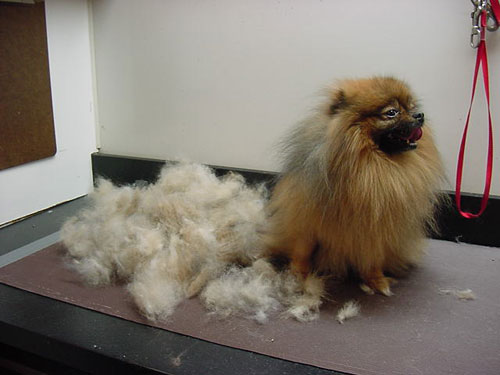 Dog hair grows and dies just as human hair does. Some dogs, particularly hard-coated terriers and Poodles, hang on to their dead hair requiring special grooming to remove it. Other dogs give it up quite readily all over the house. Double-coated dogs generally drop their soft undercoats twice a year and lose their guard hairs once a year, although some individual dogs might shed constantly or only every 10-12 months. Shedding can take anywhere from 3 weeks to 2 months. A warm bath helps accelerate the process and daily (or twice-daily) grooming can help control clouds of hair that scurry into corners and under furniture.
Dog hair grows and dies just as human hair does. Some dogs, particularly hard-coated terriers and Poodles, hang on to their dead hair requiring special grooming to remove it. Other dogs give it up quite readily all over the house. Double-coated dogs generally drop their soft undercoats twice a year and lose their guard hairs once a year, although some individual dogs might shed constantly or only every 10-12 months. Shedding can take anywhere from 3 weeks to 2 months. A warm bath helps accelerate the process and daily (or twice-daily) grooming can help control clouds of hair that scurry into corners and under furniture.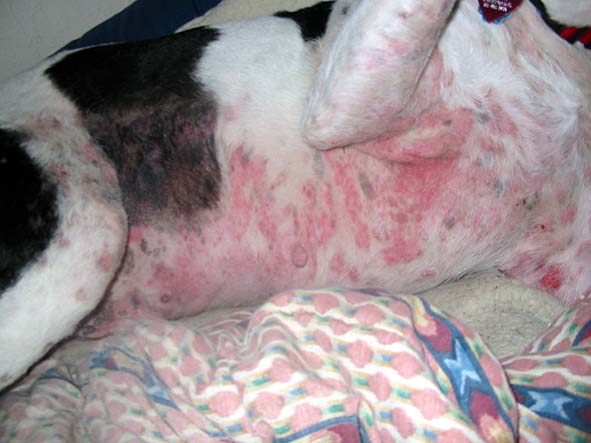 Healthy skin is certainly a consideration for a well-groomed dog, and healthy skin begins with a good diet. Again, the choices are legion. The rule of thumb is if your dog does well on the food you buy, if his skin and coat are healthy, if he has energy and enjoys life, if he is maintaining his optimum weight, if his intestines are working well, if the food is highly digestible and thus leaves little manure to clean up, keep on keeping' on. But if the dog's energy level is low, if his coat is dull and his skin dry and itchy or sore, if a vet check shows no thyroid or other medical condition to account for the anomalies, consider switching the diet or supplementing with fatty acids.
Healthy skin is certainly a consideration for a well-groomed dog, and healthy skin begins with a good diet. Again, the choices are legion. The rule of thumb is if your dog does well on the food you buy, if his skin and coat are healthy, if he has energy and enjoys life, if he is maintaining his optimum weight, if his intestines are working well, if the food is highly digestible and thus leaves little manure to clean up, keep on keeping' on. But if the dog's energy level is low, if his coat is dull and his skin dry and itchy or sore, if a vet check shows no thyroid or other medical condition to account for the anomalies, consider switching the diet or supplementing with fatty acids.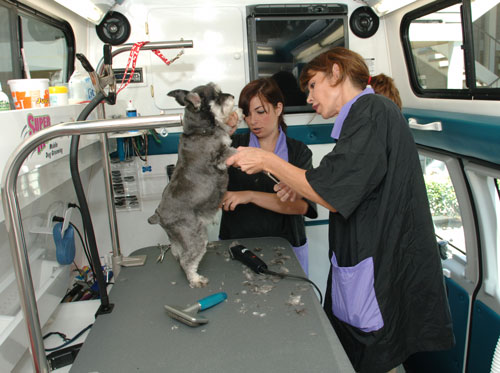 If you decide that you have neither the time, inclination or physical ability to groom your dog, there are dozens of professional groomers who can do the job. But the choice is far more complex than a digital walk through the Yellow Pages.
If you decide that you have neither the time, inclination or physical ability to groom your dog, there are dozens of professional groomers who can do the job. But the choice is far more complex than a digital walk through the Yellow Pages.